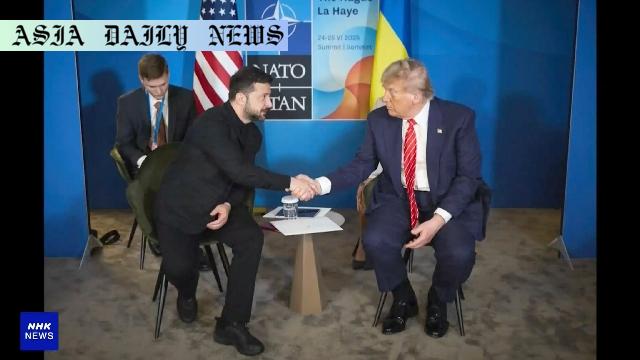Ukraine: Trump expresses hope for lasting ceasefire and plans to discuss de-escalation with Putin after NATO summit meeting.

Trump and Zelenskyy Discuss Route to Peace in Ukraine
US President Donald Trump met with Ukrainian President Volodymyr Zelenskyy on the sidelines of the NATO summit in The Hague. The discussions, which lasted approximately 50 minutes, centered on efforts to achieve a ceasefire in Ukraine’s conflict and outline steps towards lasting peace in the region. Zelenskyy took to social media to express optimism about the meeting, emphasizing his commitment to exploring solutions that pave the way for stability and security in Ukraine.
Trump described the conversation as productive and stated that he intends to bring Russian President Vladimir Putin into the dialogue. Despite acknowledging Putin as “difficult,” Trump remained hopeful about the prospect of peacebuilding efforts. Trump emphasized that both the Ukrainian leadership and NATO allies are keen on finding practical resolutions to resolve the conflict alleviating years of tensions.
NATO’s New Defense Commitment Spurred by Long-Term Threats
During the NATO Summit, leaders of member nations agreed on a groundbreaking decision: raising defense spending to 5% of GDP. This decision, according to Trump, represents a critical milestone that demonstrates the alliance’s solidarity and commitment to counter any threats, particularly one stemming from Russia. Trump referred to this shift as one ‘nobody thought possible’ due to the financial and political hurdles involved.
This decision aligns with the broader concerns about long-standing threats posed by Russian activities in Eastern Europe and their implications globally. By committing to this new level of defense spending, NATO aims to reinforce collective security and strengthen its ability to respond to emerging challenges.
Trump to Speak with Putin on Ukraine and Broader Challenges
Trump’s determination to engage with Vladimir Putin on Ukraine demonstrates his active role in foreign diplomacy. While Trump called Putin a challenging figure to negotiate with, he remains devoted to initiating dialogue aimed at achieving results. The last few years have seen complex interactions between the United States, NATO, and Russia, and this effort signifies a renewed focus on shifting the narrative and bringing some level of stability to global power relations.
The Trump-Zelenskyy meeting suggests an increased sense of urgency from the US to mitigate existing tensions. Ukraine bears the brunt of conflict and unrest, making peace negotiations not only critical for its citizens but a central piece in reducing geopolitical friction.
Future Implications for NATO and Global Politics
The broader implications of NATO’s 5% defense spending decision and Trump’s initiative to broker peace in Ukraine potentially holds transformative outcomes for global politics. With the collective commitment from NATO nations, the organization is cementing its ability to act decisively on external threats. Meanwhile, Trump’s attempts at peace negotiations could serve as a blueprint for resolving other conflicts worldwide, provided tangible results emerge.
However, challenges remain significant, particularly with the inclusion of Russia in these talks and its fraught relationship with Western nations. It remains to be seen how effectively all stakeholders navigate these sensitive interactions and whether lasting peace can be a feasible outcome. Strong multilateral cooperation and a willingness to compromise will undoubtedly play a crucial role in the success or failure of these endeavors.
Commentary
Trump’s Renewed Focus on Ukraine Shows Global Leadership
President Trump’s meeting with President Zelenskyy serves as a timely reminder of the pressing need for diplomatic interventions in global conflicts. The ongoing crisis in Ukraine, fueled by tensions with Russia, has left a deep impact on the region and its people. Trump’s initiative to further peace talks displays a willingness to shoulder responsibility and attempt a renewed effort in resolving long-standing geopolitical disputes. It’s a positive gesture from the US, one that many hope will bring sustained attention to Ukraine’s situation.
NATO’s Robust Stance: A Unified Force Amid Growing Challenges
NATO’s decision to increase defense spending signals a collective acknowledgment of rising threats and the necessity of preparedness. This historic change could pave the way for stronger alliances and better coordination in tackling hostile actions. For nations directly impacted by external aggressions, such as Ukraine, NATO’s support might provide the security assurances needed during these politically tumultuous times. The 5% commitment reflects unprecedented solidarity within NATO, highlighting the alliance’s dedication to global stability and defense.
Optimism for Peace, but Significant Challenges Lie Ahead
While the dialogue between Trump and Zelenskyy provides hope, the complexities associated with negotiating peace with Russia cannot be overstated. Past diplomatic attempts have demonstrated just how delicate such discussions can be. Reaching a consensus that benefits all involved—especially Ukraine—requires a nuanced approach and unrelenting persistence. Trump’s leadership will be scrutinized on how effectively he translates words into action, especially when dealing with President Putin, whom he has labeled as a ‘difficult’ counterpart.
Overall, the possibilities of peace and NATO’s proactive measures reflect a positive trajectory, though the global community will be closely monitoring outcomes before celebrating any milestone. There’s no doubt, however, that efforts like these are indispensable in fostering global peace and cooperation.


